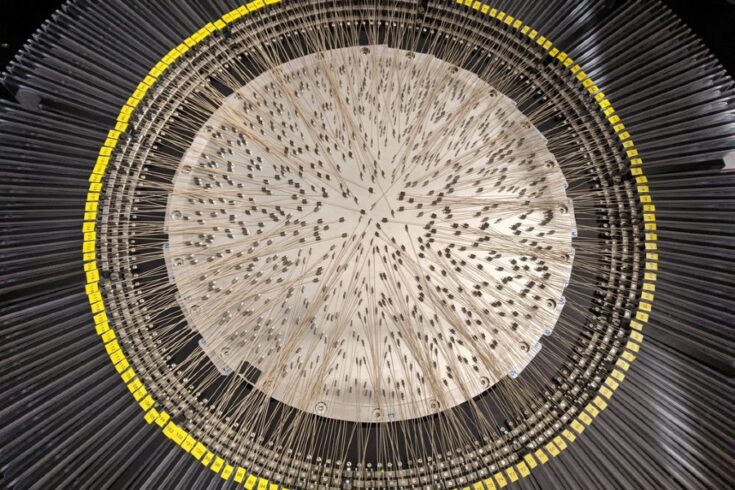UK-led robotic sky-scanner takes its place on telescope
12 Jul 2021 03:34 PM
A major telescope upgrade, which will allow a comprehensive census of the universe to answer fundamental astrophysical questions, is now close to completion.

A fully-configured WEAVE field, with 700 of around 950 fibres placed by two robots (out of frame), on location in the WHT (credit: Gavin Dalton, University of Oxford and STFC’s RAL Space).
In a significant milestone for the project, all the main components of a new instrument for the William Herschel Telescope (WHT) are now being tested and integrated.
The WHT Enhanced Area Velocity Explorer (WEAVE) (RAL Space website) is an unique upgrade to the WHT.
It will extend the telescope’s field of view to two degrees on the sky in order to increase the rate of measurements to up to 1,000 stars per hour.
The WHT is part of the Isaac Newton Group (ING) of telescopes in La Palma, the Canaries.
The Science and Technology Facilities Council (STFC) is a partner with Spain and the Netherlands in the operation of the WHT.
Understanding our galaxy and dark energy
The components for WEAVE have arrived at the Canary Islands.
The system is now being tested and integrated to the telescope ready to begin the on-sky commissioning phase before the instrument begins a 1,200-night survey over the next five years.
The more than 12 million spectra collected by WEAVE will provide critical data to enhance the science return from Gaia (the European Space Agency’s Milky Way mapper).
In particular, WEAVE will enable the mapping of the dark matter distribution in the Milky Way.
It will also allow studies of the formation and evolution of galaxies across cosmic time, and the interactions between the stellar content of galaxies and their central black holes.
Professor Scott Trager, WEAVE project scientist and chair of the WEAVE Survey Consortium, Kapteyn Astronomical Institute, University of Groningen yesterday said:
We are very excited to see WEAVE reach this important milestone.
WEAVE will provide tens of millions of spectra of stars and galaxies over the coming five years, and the WEAVE Survey will provide data that will help answer questions like how did our galaxy form and the stars within it evolve, how were other galaxies assembled, and what are dark matter and dark energy?
WEAVE in the UK
The UK has led the European consortium to design and produce this major new instrument, with around 20 million Euros provided by STFC.
WEAVE is led by the University of Oxford and STFC RAL Space.
Additional technology is supplied by Liverpool John Moores University and a complex data processing pipeline development led by the University of Cambridge.
Professor Gavin Dalton, WEAVE principal investigator, University of Oxford and STFC RAL Space, yesterday said:
It is tremendous to see the sustained efforts of so many groups of people finally coming together at the telescope, and to finally be able to bring the system to operation.
WEAVE has been 10 years in development with lots of complex moving parts and components scattered in laboratories across Europe.
With everything now at the telescope and operating correctly we are on the cusp of offering astronomers a new and improved eye on the stars.
The technology behind the observations
Following a year of painstaking installation of close to 100km of optical fibre assemblies WEAVE’s fibre positioner has made the journey from the UK and has now been tested and calibrated.
The positioner is able to place full configurations of over 900 fibres in under one hour using its two high-speed industrial robots.
Each fibre collects light from an individual star or galaxy which is fed to the spectrograph.
The WEAVE spectrograph has already been installed at the WHT.
It has two arms, each with its own custom-built cryostat, a liquid-nitrogen refrigeration unit which will cool the detectors to help limit background ‘noise’, to produce much clearer spectra.
Tests of the spectrograph have already produced high quality images at all wavelengths from the ultraviolet to the far red. Each fibre can collect the light from a single star or galaxy.
On-sky commissioning to surveying the sky
The on-sky commissioning of WEAVE will begin after integration of the instrument. This will be followed by science verification observations.
WEAVE will be operated by the ING which will then commence routine survey and open-time observing.
Further information
WEAVE
The main components of WEAVE are:
- the prime-focus corrector, designed by ING, provided by the Astrophysical Institute of the Canaries (IAC) in Spain with support from Konkoly Observatory in Hungary
- the fibre-positioner, developed by the University of Oxford
- fibres, designed by the Observatoire de Paris in France, manufactured in France, Canada and the US
- spectrograph, built by Netherlands Research School for Astronomy (NOVA). With optical design by RAL Space, optics manufactured at National Institute for Astrophysics, Optics and Electronics (INAOE) in Mexico and support from National Institute for Astrophysics (INAF) in Italy and the IAC
- detectors system, provided by Liverpool John Moores University
- data processing, analysis and archiving, led by the University of Cambridge, with support from the IAC, and INAF.
The ING
The ING is funded by:
- STFC
- Dutch Science Foundation
- the IAC.
IAC’s contribution to ING is funded by the Spanish Ministry of Science, Innovation and Universities.